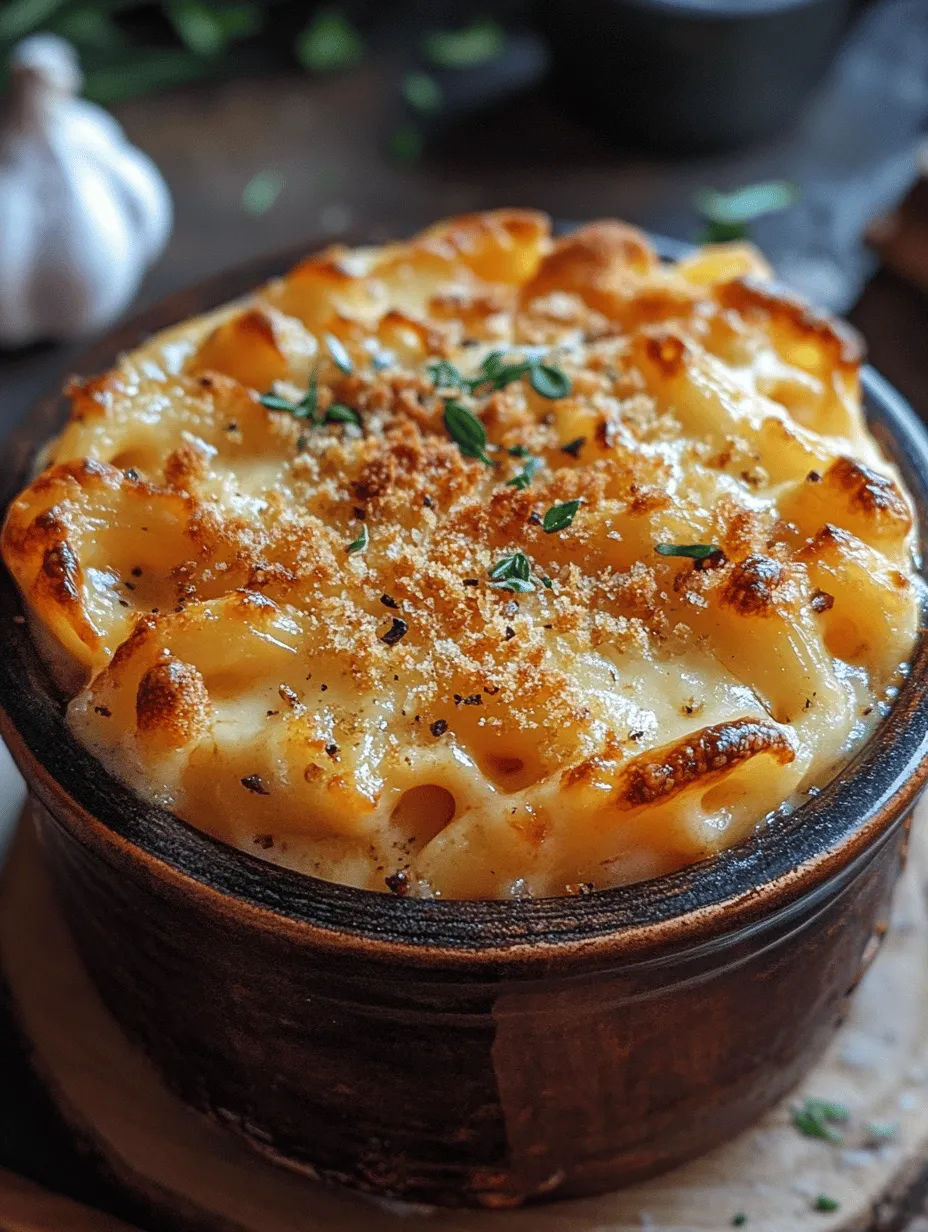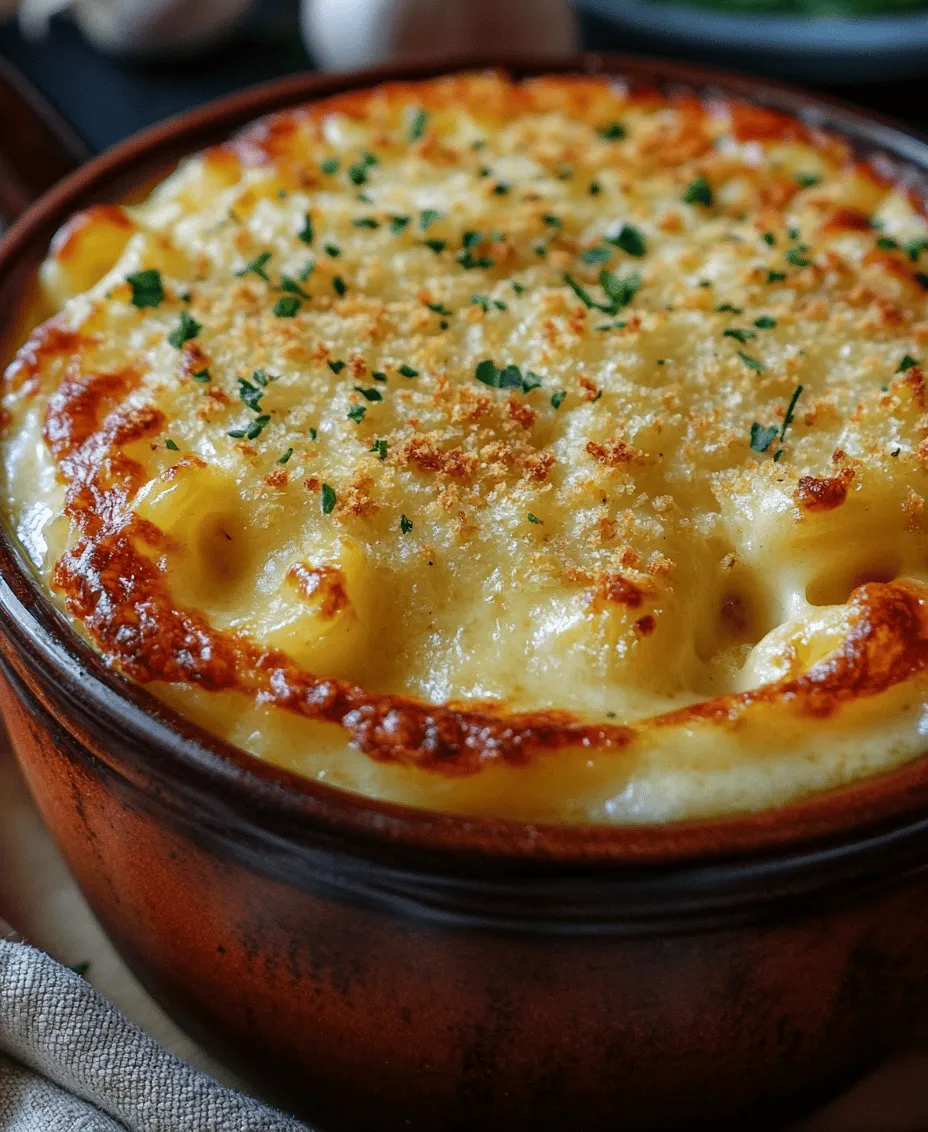When it comes to comfort food, few dishes evoke the same sense of nostalgia and satisfaction as a warm, creamy bowl of mac and cheese. This beloved classic has transcended generations, making its way onto dining tables across the globe. Whether enjoyed as a simple weeknight dinner or served at festive gatherings, mac and cheese has earned its place in the hearts of many. In this article, we will delve into the allure of homemade mac and cheese, highlighting why preparing it from scratch is essential for a truly delightful experience.
The Importance of Homemade Mac & Cheese
While pre-packaged mac and cheese may offer convenience, it often falls short in flavor and texture compared to its homemade counterpart. Store-bought versions may be quick and easy, but they can’t replicate the rich, creamy sauce or the satisfaction that comes from crafting the dish yourself. Homemade mac and cheese allows for personalization; the choice of cheeses, spices, and even toppings can be tailored to suit individual preferences. This versatility not only enhances the taste but also adds a layer of creativity to the cooking process.
In the following sections, we will introduce our featured recipe: Comforting Classic Mac & Cheese. This rendition captures the essence of traditional mac and cheese while incorporating a few surprises that elevate its flavor and texture, making it a dish you’ll revisit time and time again.
Understanding the Appeal of Mac & Cheese
Historical Background of Mac and Cheese in American Cuisine
Mac and cheese has deep roots in American culinary history. Its origins can be traced back to Italy, where a dish called “maccheroni” was prepared with cheese in the 1700s. However, it wasn’t until the dish made its way to America that it truly evolved into the comfort food we know today. Thomas Jefferson is often credited with popularizing macaroni and cheese in the United States after he encountered it during his travels in Europe. He brought back recipes and even served it at an 1802 dinner in the White House, marking the beginning of its journey into American kitchens.
Over the years, mac and cheese has become a staple in American households, featured prominently in cookbooks and menus alike. Its simple preparation and heartwarming flavors resonate with people of all ages, making it a timeless favorite.
Cultural Significance and Variations Across Different Regions
Mac and cheese is more than just a dish; it’s a cultural touchstone that varies significantly from region to region. In the southern United States, for example, you might find mac and cheese baked with a crispy topping of breadcrumbs, while in the northeast, creamy stovetop versions reign supreme. Some variations incorporate ingredients like crab, lobster, or even vegetables, showcasing the dish’s adaptability to different tastes and occasions.
In addition, mac and cheese plays a pivotal role in celebrations and gatherings, often served at barbecues, holiday feasts, and family reunions. Its comforting qualities make it a go-to dish for both casual meals and special occasions, solidifying its status as a beloved comfort food.
Why Mac & Cheese Stands Out as a Comfort Food Staple
So, what is it about mac and cheese that makes it so special? The answer lies in its unique combination of flavors and textures. The creamy cheese sauce enveloping the tender pasta creates a sensory experience that is both indulgent and satisfying. The taste of melted cheese, combined with the comforting embrace of pasta, evokes feelings of warmth and happiness, reminiscent of home-cooked meals and cherished family traditions.
Furthermore, mac and cheese has an innate ability to bring people together. It’s a dish that sparks conversations and encourages sharing, often enjoyed in the company of loved ones. Whether it’s a cozy family dinner or a potluck with friends, mac and cheese is a dish that fosters connection and creates lasting memories.
Ingredients Breakdown
To create the ultimate Comforting Classic Mac & Cheese, it’s essential to understand the role of each ingredient in this beloved dish. Here’s a closer look at the key components that come together to form the heart of this recipe.
Elbow Macaroni: The Classic Choice
Elbow macaroni is the quintessential pasta choice for mac and cheese. Its small, curved shape allows for optimal cheese sauce adherence, ensuring each bite is packed with flavor. The texture of al dente elbow macaroni provides a satisfying chew, complementing the creamy sauce perfectly. While other pasta shapes can be used, such as shells or cavatappi, elbow macaroni remains the most popular due to its tradition and familiarity.
Butter and Flour: Creating the Roux
The combination of butter and flour is the foundation of the cheese sauce, known as a roux. Butter is melted in a saucepan, followed by the addition of flour, which helps thicken the sauce. Cooking the roux for a few minutes enhances the nutty flavor and removes any raw flour taste. This step is crucial for achieving a smooth and velvety cheese sauce that coats the pasta beautifully.
Whole Milk: Importance of Creaminess
Using whole milk in the cheese sauce adds a rich creaminess that elevates the overall flavor of the dish. The fat content in whole milk contributes to a luscious texture, ensuring that the sauce is both thick and creamy. While some recipes may call for lighter alternatives, opting for whole milk will yield the best results in terms of taste and mouthfeel.
Cheese Selections: Flavor Profile of Sharp Cheddar and Gruyère
The choice of cheese is perhaps the most critical aspect of mac and cheese. For this recipe, we recommend a combination of sharp cheddar and Gruyère. Sharp cheddar provides a tangy, robust flavor that is synonymous with traditional mac and cheese, while Gruyère adds a touch of nuttiness and depth. The melting qualities of these cheeses ensure a creamy, cohesive sauce that clings to the pasta. Feel free to experiment with additional cheeses like mozzarella or fontina for added complexity.
Spices: Enhancing Flavor
Though cheese is the star of the show, spices play a vital role in enhancing the overall flavor profile of mac and cheese. A blend of garlic powder, onion powder, mustard powder, and paprika adds depth and warmth to the sauce. These spices complement the cheese without overpowering it, ensuring a well-rounded dish. Adjusting the spice levels to suit your taste can create a personalized touch that makes the recipe your own.
Optional Toppings: The Appeal of Breadcrumbs and Olive Oil for Crunch
For those who enjoy a bit of crunch, adding a topping of breadcrumbs and olive oil is a delightful option. The breadcrumbs become golden and crispy when baked, providing a satisfying contrast to the creamy interior of the mac and cheese. A drizzle of olive oil enhances the flavor while keeping the topping moist. This simple addition can elevate your mac and cheese from ordinary to extraordinary.
Step-by-Step Guide to Making Comforting Classic Mac & Cheese
Now that we’ve explored the ingredients that make up our Comforting Classic Mac & Cheese, it’s time to dive into the step-by-step instructions for creating this delightful dish. Follow along closely to achieve the perfect balance of flavors and textures.
Cooking the Pasta to Al Dente
The first step in making mac and cheese is cooking the pasta. Start by bringing a large pot of salted water to a rolling boil. Once boiling, add the elbow macaroni and cook according to the package instructions until al dente. This typically takes around 7-8 minutes; however, it’s important to taste the pasta a minute or two before the suggested time to ensure it’s perfectly cooked. Al dente pasta will have a slight firmness in the center, which is key to preventing mushiness when mixed with the cheese sauce.
Once the pasta is cooked to perfection, drain it in a colander and rinse it briefly under cold water to stop the cooking process. Set the pasta aside while you prepare the cheese sauce.
Creating the Roux
Next, it’s time to create the roux, which will form the base of your cheese sauce. In a large saucepan or pot, melt 4 tablespoons of butter over medium heat. Once the butter has completely melted, sprinkle in 4 tablespoons of all-purpose flour. Stir the mixture continuously with a whisk or wooden spoon for about 2-3 minutes. This cooking time is crucial, as it allows the flour to absorb the butter and develop a slightly golden hue, enhancing the sauce’s flavor.
After the roux has cooked, gradually pour in 3 cups of whole milk while whisking constantly. This step ensures a smooth sauce without lumps. Continue to cook the mixture over medium heat, stirring frequently, until it thickens and begins to bubble. This process generally takes around 5-7 minutes.
By following these foundational steps, you are well on your way to creating a comforting and delicious mac and cheese that will surely become a favorite in your household. Stay tuned for the continuation of this recipe, where we will explore the addition of cheeses and the final assembly of this classic dish.
Adding Milk: Techniques to Prevent Lumps and Ensure Smoothness
When preparing your cheese sauce for mac and cheese, adding milk is a crucial step. It’s essential to ensure a smooth, creamy consistency without lumps. To achieve this, start by gradually adding the milk to your roux (the mixture of flour and butter) while whisking continuously. This technique prevents the flour from clumping together and allows it to incorporate smoothly into the liquid.
For best results, use warm milk instead of cold. Warm milk helps to maintain the temperature of the roux, preventing it from seizing up and forming lumps. If you accidentally encounter lumps, you can use an immersion blender to blend the sauce until smooth. Remember to keep the heat on medium-low while adding the milk, which helps to achieve that perfect creamy texture.
Seasoning the Sauce: Balancing Flavors for Maximum Impact
The key to a delicious mac and cheese lies in the seasoning of your cheese sauce. Start by incorporating salt and pepper to taste, but don’t stop there! Consider adding a pinch of garlic powder, onion powder, or even a dash of cayenne pepper for a subtle kick.
For a more complex flavor profile, you can also include Dijon mustard or Worcestershire sauce. These ingredients enhance the overall taste of the sauce, creating a rich and comforting flavor that elevates your mac and cheese. Be sure to taste the sauce as you go, adjusting the seasoning until it perfectly balances the rich creaminess of the cheese.
Melting the Cheese: Ensuring a Silky, Cohesive Cheese Sauce
The type and method of melting the cheese can significantly impact the texture of your mac and cheese. Choose a combination of cheeses for a more nuanced flavor. Cheddar is a classic choice, but you can also experiment with Gruyère, Monterey Jack, or even a bit of cream cheese for extra creaminess.
When melting the cheese, add it gradually to the warm sauce off the heat. This method allows the cheese to melt slowly and evenly, preventing it from becoming grainy or oily. Stir the cheese in until it is fully melted and the sauce is smooth and cohesive. If the sauce seems too thick, you can add a splash of milk to reach your desired consistency.
Combining Pasta and Sauce: Techniques for Thorough Coating
Once your cheese sauce is velvety smooth, it’s time to combine it with the pasta. Make sure your pasta is cooked al dente and drained well to avoid excess water diluting your sauce. In a large mixing bowl or pot, add the pasta, then pour the cheese sauce over it.
To ensure every piece of pasta is evenly coated, gently fold the pasta into the sauce using a spatula or wooden spoon. Be careful not to overmix, as this can break apart the pasta. Once all the pasta is coated, you can either serve it immediately or transfer it to a baking dish for an optional breadcrumb topping.
Optional Breadcrumb Topping: Instructions for Adding Crunch and Baking
For those who enjoy a crunchy texture contrast in their mac and cheese, a breadcrumb topping is an excellent addition. To create this topping, mix together breadcrumbs with melted butter, and season with salt and pepper. You can also add grated Parmesan cheese or herbs for extra flavor.
Spread the mac and cheese into a greased baking dish and sprinkle the breadcrumb mixture evenly over the top. Bake in a preheated oven at 350°F (175°C) for about 20-25 minutes, or until the breadcrumbs are golden brown and crispy. This step not only adds texture but enhances the visual appeal of your dish.
Variations and Customizations
One of the best aspects of mac and cheese is its versatility. Whether you want to stick to the classic recipe or explore new flavors, there are endless possibilities for customization.
Exploring Different Types of Cheese That Can Be Used
While cheddar is the go-to cheese for mac and cheese, don’t shy away from experimenting with different varieties. A blend of sharp cheddar and creamy Havarti creates a delightful contrast in flavors. For a more gourmet twist, consider incorporating smoked Gouda or blue cheese, which adds a unique flavor that elevates the dish to a new level.
Adding Proteins: Incorporating Chicken, Bacon, or Vegetables
For a heartier meal, consider adding protein sources to your mac and cheese. Cooked, shredded chicken or crispy bacon enhances the dish with savory flavor. If you prefer a vegetarian option, sautéed spinach, broccoli, or roasted tomatoes can be added for a nutritious boost.
Creative Twists: Introducing Herbs, Spices, or Alternative Toppings
Incorporating fresh herbs like thyme, basil, or parsley can add a refreshing element to your mac and cheese. Additionally, spices such as smoked paprika or a hint of nutmeg can intensify the flavors. For those looking for alternative toppings, consider adding caramelized onions or sautéed mushrooms for a gourmet touch.
Gluten-Free Options: Swapping Elbow Macaroni for Gluten-Free Pasta
If you’re catering to gluten-free diets, simply substitute traditional elbow macaroni with gluten-free pasta options. There are numerous varieties available, such as rice or chickpea pasta, that work wonderfully in mac and cheese recipes. Just be sure to follow the cooking instructions on the package, as gluten-free pasta may have different cooking times.
Serving Suggestions
The presentation of your mac and cheese can enhance the dining experience. Serve in individual ramekins for a personal touch, or in a large baking dish for a family-style meal. A sprinkle of fresh herbs on top adds a pop of color and freshness.
Best Sides to Complement the Dish: Salads, Vegetables, or Bread
Mac and cheese can be quite rich, so pairing it with lighter sides can create a well-rounded meal. A simple green salad dressed with vinaigrette offers a refreshing contrast. Steamed or roasted vegetables can also provide a healthy balance. If you’re looking for something more indulgent, serve with garlic bread or a side of coleslaw.
Storing and Reheating Leftovers: Maintaining Flavor and Texture Over Time
If you have leftovers, store them in an airtight container in the refrigerator for up to three days. When reheating, add a splash of milk to the mac and cheese to restore its creamy texture. Heat in the microwave or on the stovetop over low heat, stirring occasionally until warmed through. Avoid reheating at high temperatures, as this can dry out the pasta and cheese.
Nutritional Information
Homemade mac and cheese can be a hearty comfort food option, but understanding its nutritional profile is essential for balanced meal planning.
Overview of the Nutritional Profile of the Recipe
A standard serving of mac and cheese, depending on recipe variations and portion sizes, can range from 300 to 600 calories. It typically contains carbohydrates from the pasta, protein from the cheese, and fat from the butter and cheese used in the sauce.
Discussion of Portion Sizes and Balance with a Healthy Diet
When enjoying mac and cheese, consider the portion size. A typical serving is about one cup, which can be complemented with a side salad or vegetables to increase fiber content and nutritional balance.
Considerations for Dietary Restrictions and Adaptations
For those with specific dietary needs, such as lactose intolerance, consider using lactose-free cheese and milk. Plant-based options can also be made using vegan cheese and non-dairy milk alternatives. Always check labels for gluten-free products if required.
Conclusion
Homemade mac and cheese is truly the epitome of comfort food. Its creamy texture, rich flavor, and satisfying nature make it a favorite among many. The beauty of this dish lies in its versatility—allowing you to personalize it to suit your taste and dietary preferences.
Whether you stick to the classic recipe or venture into creative variations with different cheeses, proteins, or toppings, the joy of cooking and sharing this beloved dish is what truly makes it special. So gather your ingredients, embrace your creativity, and enjoy the process of crafting your comforting classic mac and cheese. Bon appétit!



